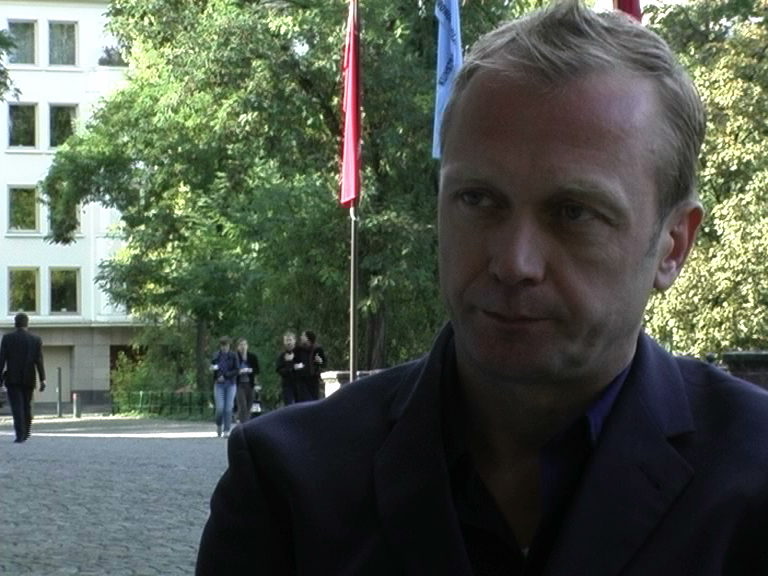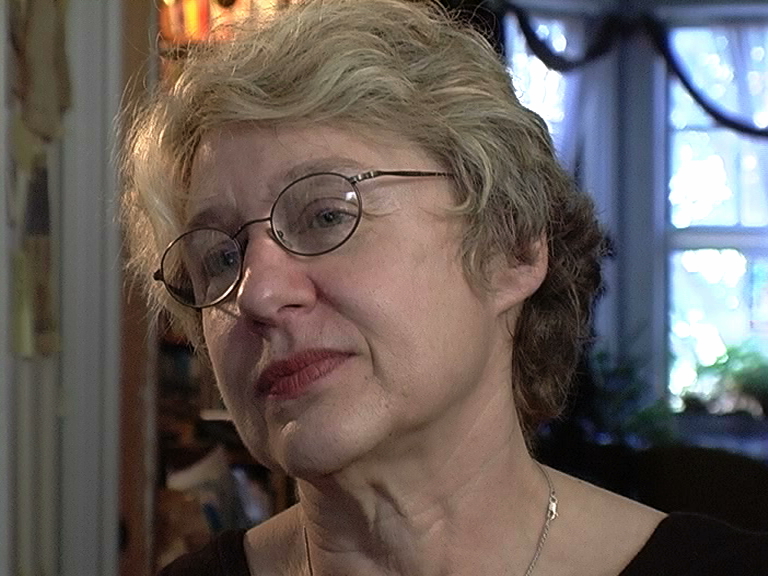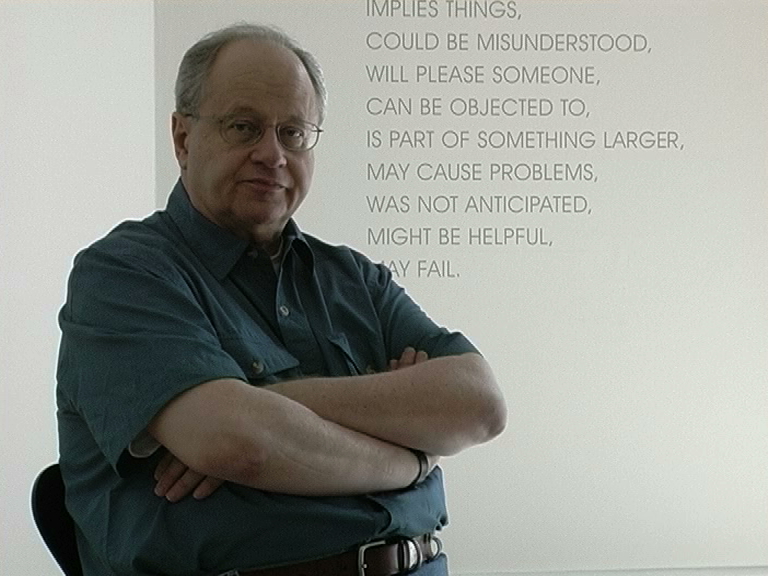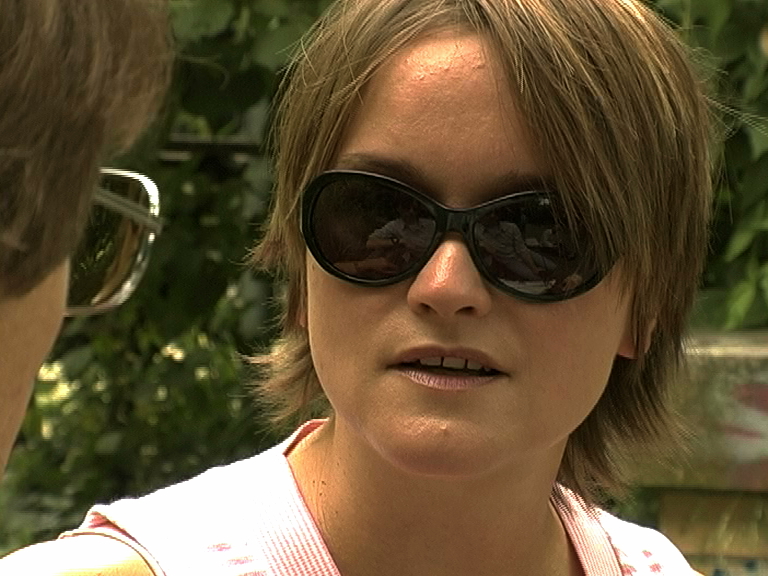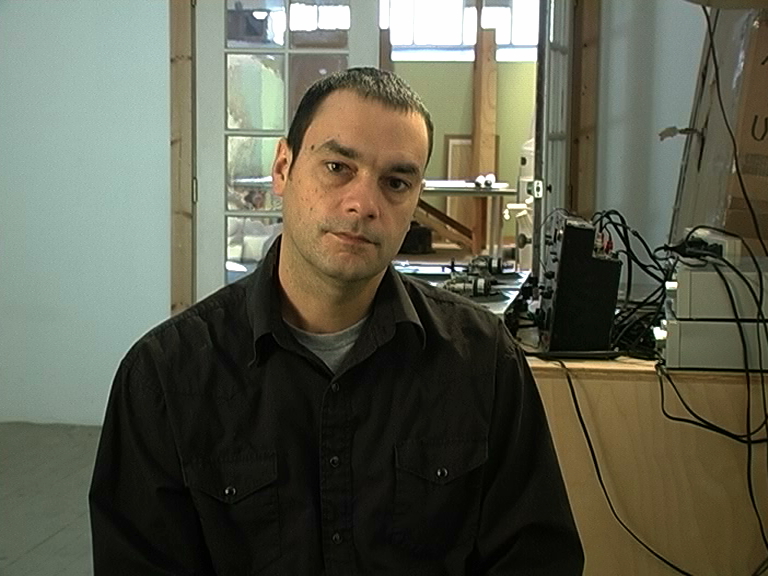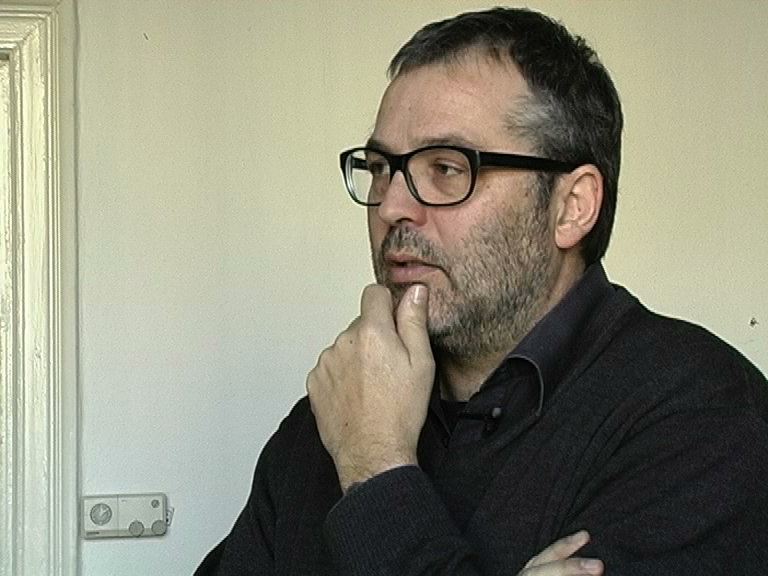S.R.: We are guests of Charles Harrison in Oxford on November 29th, 2004, and my first question is: How did you start to work together with the collective Art & Language, what was the starting point for you?
C.H.: It was gradual. I was working at Studio International, the magazine in London, as an assistant editor and I’d had heard a little bit about the activities of Art & Language in Coventry from a colleague who was then associated with the international American girl called Barbara Rice. She was teaching at Coventry, so she knew the people there. So I heard a little bit about them and about the work they were doing, and then Terry Atkinson and Harold Hurrell from the original group of Art & Language came to see me at Studio, bringing some materials. They were just introducing themselves as artists to somebody who worked on an art magazine. I found it very interesting because they were very different from the other artists I met. They looked a little bit more like… well, they had suits and briefcases, you know, not quite like an artist, and Harold was very depressed. Shortly after that hype in the spring of 1969 I went to New York. I went partly because I wanted to meet Clement Greenberg and I wanted to see more American painting, and I met Joseph Kosuth. I met him in a Kenneth Noland exhibition in Larry Luton’s gallery and we got talking and he latched on to me as somebody who was an English art critic and took me around, introduced me to people in New York. So through him I met Lucy Lippard and the Seth Siegelaub stable of artists. When I came back to England I was keen to try and get more involved with the kind of work that I had seen in New York, I think and renewed my contacts with the Art & Language people. I can’t remember exactly how that happened but I do remember being invited up to Coventry to talk. I think it must have been by Terry where I met Michael and David Bainbridge. That confirmed my sense that these were interesting people. I think that also I was very uncertain about what I was doing. I wanted to be an art critic and entrepreneur and a curator but I started to find that this kind of career that I thought I had set up to myself didn’t really work, and I explain more about why not in a little while. And I didn’t really know why it wasn’t working why the competence that I thought I had didn’t seem to give me the results that I hoped for, but these were people who knew why, they knew what was wrong with having sensitivity, culture, and class in a context with art, why that didn’t work any more I suppose, and I felt increasingly that they were people I could learn from, I suppose, but I was still then working as a exhibition organiser critic and so what I tried to do was to get involved with them in that roll and so initially I developed my contact with Art & Language by trying to organise exhibitions with their working and put them into exhibitions that I had a chance to organise by writing about that work also and through that I became more closely involved with the group. I remember writing an article about Art & Language, Burgin, and Kosuth in Studio, I think in 1970 and what I remember from that is I remember Michael Baldwin coming on to visit my house in London where I was then living. The first he said was: “Your article was shit.“ And I said how good, Art & Language was so important. That was not a reaction I’d had from any of the other artists I had written about and it was interesting – and he was right. So it increased my sense that these were people that I could learn with. So I suppose I worked to become more closely involved. The other strong contact was through the magazine through Art & Language which I was certainly interested in, but partly i was interested because I didn’t understand it. That was the thing that made it interesting: it was really difficult and strange. But it was also full of mistakes, and I am quite a competent editor and I couldn’t bear the fact that this interesting material was being spoiled slightly by the fact that you couldn’t tell a difference between what was difficult and what was a radiant form of mistake. So I offered my services as an editor to the magazine just to try and get some of the mistakes out, and I became initially more closely involved with Art & Language just as a working editor. but of course what happened with Art & Language is that those who join in the work, and particularly those who try and maintain the road of critics, become drawn into the production. So I just got gradually more closely to the journal.
S.R.: What was the challenge of this project?
C.H.: The project of Art & Language?
S.R.: Yes.
C.H.: Partly its sheer difficulty, it was also strange. They were making claims for a kind of artistic status for works that took a form, simply the form of texts that were very hard to understand, hard to read. So there was a kind of intellectual challenge. But it also was work that seemed to have kind of a critical purchase on the standard kind of modernist fare of the time, and that made it interesting and I think it made it particularly interesting to me because I was trying to be a competent and sophisticated consumer of modernist art and couldn’t work out why I was failing.
S.R.: In respect of the last 30 years, how did the circumstances change in the 80s and the 90s to the contemporary art field?
C.H.: That’s a very difficult one to answer, I think. Partly what changed was the character of the market, and I think that some of the barriers between art and the commercial world became eroded. I suppose that when the sense was a long term consequence at the decline of some modernist criticals, that notion that the aesthetic and the commercial were each other’s necessary opposites and that division that we’ve in Art & Language we have sort of caricatured as on the one side and the artist does it in and out of necessity, and the rest of the world does it for the money. So if you’d say the artist is doing it for the money than it says you are compromising what is supposed to be special about art? I think that idea, that division, with so many of the other things that went to me in the 80s and 90s, that just collapsed, and one of the consequences of that was that it broke down the boundaries between the notion of high art on the one hand and the popular arts on the other. And that favoured a generation of artists who would always perhaps felt a lot closer to the world of popular culture than the world of high culture, so that you get artists who see themselves ideally as much more like rock stars than like the traditional artist working way in a lonely studio and trying to put himself onto the canvas. So maybe… that was a lie to the fact that increasingly those responsible for the distribution of art, the gallerists, the curators, and so on tended to see themselves also rather more like publishers, like advertising executives and so on, rather like discriminating connoisseurs So you just get a change in the whole of images, I think of the business of the art world, I think. So that the notion of artist what the career is, of being an artist, represents that changes. And I think most of the changes are driven by substantial changes in the sort of economical cultural base of society – coinciding with the shift away from modernist values, so that may itself be partly determining by what was happening with the social and economic base.
S.R.: For example, we can come to a kind of a re-doing? For example “When Attitudes Become Form“ – there was a second exhibition in the 1980s, I think there was a reprise of “When Attitudes Become Form“.
C.H.: In Cambridge, that one?
S.R: Yeah. When was it?
C.H.: 1983.
S.R.: For example what was the motivation to re-do an exhibition in parts again?
C.H.: I think there are two reasons for that, one – and they are connected – one was that you began to get a new generation of curators who perhaps were young when the first exhibition was shown who had then gone along to study modern art history and have maybe done their gradual work on the original conceptual art movement and so now they are organising their shows connected to a kind of graduate work of art history students. I think that was part of the reason why that particular show was organised in Cambridge. It was organised by somebody who had done her graduate thesis on the “Attitudes“ show, I think. And then, of course, that’s the reason that conceptual art movement generally starts to become fashionable, as always happens after a certain lapse of time. So the work starts to cause a value in a certain… things start getting to the museums, and it’s time to have another look.
I mean, it’s interesting that the two English exhibitions that had been related to the “Attitudes“ show, that one and the more recent one at the Whitechapel, have both removed the essentially cosmopolitan character of the original exhibition and turned them into sort of exhibitions of a solely British avant-garde which felt like rather a defeat in comparison tot he initial exercise, and turned them into little exercises in provincial celebration.
S.R.: If I connect this question of re-doing an exhibition of Conceptual Art, we are all the time talking about Conceptual Art. It must be allowed to ask if there is something like conceptual paradigms in your interest as an art historian. Do you think that these, if there are or there where some paradigms, conceptual paradigms, which is denied by some artists, and are they still in function?
C.H: I think there are certain things. Firstly, speaking as an art historian, I would say there is no denying that there was something that we now, for convenience, call the Conceptual Art movement, and so there was a substantial shift in the character of avant-garde practice over a very wide area, that was an international movement. You can date it reasonably precisely to a period between about 1965 and 1972, and there were several large survey exhibitions at the time which collected together artists of that generation, tried to… I mean all kind of names were applied to the movement. Conceptual art seems to be one of the ones that stuck. But of course that term gets used very widely for a lot of practises to which it perhaps doesn’t apply very well. So a lot of what gets called Conceptual art, historically speaking, I wouldn’t see as necessarily connected to the core ideas that I would associate with the Conceptual Art movement. But I think that’s very normal. But if you ask what these core ideas were, what for me makes sort of Conceptual art, it would be a particular kind of critical purchase on the break-up of the authority of modernist criticism and modernist paradigms of art. So it’s not so much that I would think of there being conceptual paradigms within the movement. It’s rather more that the idea of a critical attack on the paradigms that we associate with modernism was a factor in common between the number of interesting artists of the time. More generally, I suppose, the notion of Conceptual art, it’s had a history rather like the history of the term “abstract art“, that for much of the 20th century abstract art got used very loosely to mean stuff that looked quite strange… and wasn’t obviously figurative. But if you go back to the beginnings of the abstract art movement, if you go back to the work of Malevitch, Kandinsky, Mondrian, and in the second decade century, you are talking about a very specific set of problems and ideas, the imaginative possibilities in response to the break-up with the power of figuration to determine the category painting, and if you really want to understand that you got to go back to that moment and understand what these artists where addressing and why they felt they couldn’t go on doing what other artists have done. Similarly, if you want to go back to the Conceptual art movement you understand why it was like it was you have to understand that little nexus of problems, that made certain things seem as practices you just couldn’t carry on with anymore. So you need some act of historical reconstruction to give Conceptual art a real practical sense.
S.R.: In respect to this background and how you figured it out, there is a talk or something like a fashion, you said it became fashionable of Conceptual art in the last 10 years, more and more. How do you differentiate between, if you go beyond the generation question, how do you differentiate between the closer field of Conceptual art and the wider field. I mean today everything can be conceptual in the press releases you read that architecture is conceptual, that painting is conceptual, I mean, theatre is conceptual!
C.H.: It just becomes a label. It’s like a marketing label that gets applied to stuff, and it just means “not conventional painting“ hanging on the wall, “not conventional“ sculpture on a pedestal, “not conventional“ theatre… up to terms used almost as loosely as “experimental“. For me Conceptual art is something that was a transitional phase in art that lasted over a certain historical period, I would say, again, between the mid-60s and the early 1970s, and it was transitional. And certainly, of course, it was a factor in the kind of changes in art which we’ve seen since, of course it was, but you can’t draw a very consistent, drawn-out set of tendencies that would link everything back to that point.
S.R.: What do you consider as – beside that it was a strong critique by modernism in the middle of the 20th century – what do you consider as the strongest influence for the conceptual artists you know?…
C.H.: It’s difficult to generalize too much, I think. Again, the sense of negative possibility were very strong, in the sense that you couldn’t go on working in the same way. I think some of the strong influences of some people I knew were a kind of critique of class culture, and the sense that modernism had become a kind of institutionalised class culture that left no room for certain ways of conducting oneself, of having a career. So I think the idea that it was necessary to establish some other way of proceding was important. And then, if it’s necessary to establish a different way of proceding, then you need different intellectual resources, you need different arguments, and I think some of the younger artists started looking for critical materials that were given a purchase on the situation they found themselves in… So far as Art & Language is concerned I think the two main resources were on the one hand, the Marxist intellectual tradition which reveals one of the critique of class culture and the tradition of analytical philosophy which evolves one of the critiques of the language structure thing of the art world discourse of aesthetics. There’s an Art & Language slogan that goes “Not Marx or Wittgenstein, but Marx and Wittgenstein“, and the idea bringing those two kinds of resources together seems the strongest intellectual influence on the people I knew and was closest to.
S.R.: I mean, the artistic practice of the conceptual artists is a very intellectual practice, can be seen as very intellectual…
C.H.: Yes, it is intellectual but it is irresponsibly intellectual and opportunistically intellectual. That is to say it is not quite intellectual in the sense that following an academic curriculum is an intellectual activity. People were reading books they had no right to read, they wouldn’t have been considered as properly trained and educated to read and getting out of them whatever they could use and putting different kinds of intellectual resources together so it was slightly reading this bricolage, reading this collage – and it was intellectual in a sense that some of the materials were quite intellectually demanding materials, but they weren’t necessarily used in a standard intellectual fashion. They weren’t use to make the proper kind of intellectual product. So that something like the Art & Language Index in 1972 was a kind of intellectual product, it was made out of a lot of strange texts, but the texts were inserts at the artists sort of had produced for themselves, certainly out of some kind of strange reading, but it certainly wasn’t a standard kind of intellectual product, it wasn’t a book, it wasn’t a university course, it was an artwork.
S.R.: How do you think that this specific practice to be a very intellectual artistic have a very intellectual artistic practice. How did the circumstances change in the last 10-20 years?
C.H.: I think the idea of being some sort of a “reading artist“, as it were – that’s gone. It’s become rather unfashionable to deploy the same kind of intellectual resources. That again, I think, I would see as connected to that breakdown between the notions of the high culture and the popular culture that certainly happens, too in the 80s and 90s. But you don’t expect rock musicians to be intellectuals. And if the model for the artist to the model for the career of the artist is rather more like the rock musician’s career than it’s like Barnett Newman’s career, then you wouldn’t expect them to read that much or at least you wouldn’t expect them to talk about that they read. They’d probably keep pretty quiet about it.
S.R.: As you are talking about the role model of the rock star for a lot of contemporary artists, there is a discussion about – and it’s really relevant for our film – how the artist behaves in front of the camera, but also what can the role of the artist be, in a film, and there is the opinion that they have only two options: to play the role of the authentic artist, in what way ever, or to speak about this situation he or she is in, the production of the film. What do you think, is it appropriate to have these two options?
C.H.: Yes, except that now I suppose the authentic artist is somebody who is smart about the fact that what they’re involved in is a representation. So authenticity no longer means being an inarticulate person locked up in the privacy of your studio. Being an authentic artist means being smart and being smart about things like the fact that there’s a camera over there and we need to be conscious to the fact that we are talking in the presence of the camera. That’s just non-sophistication, isn’t it? We can’t any longer pretend that we are all alone in the world and unsurveyed and unrepresented.
S.R.: I want to close with a more personal question to your own practice. We started with your approach to Art & Language and the Conceptual art, and I am specifically interested in your own self-reflection. Do you think that the work with Art & Language and Conceptual art changed your own practice, in a way? That for example the big collection of theoretical artists’ writing “Art and Theory from 1900-2000“ is representing a specific kind of practice of art history that was not possible before.
C.H.: It’s undoubtedly true that the involvement of Art &Language changed my practice and changed my sense of what I could reasonably do. I had conventional education, I was privately educated, I went to Cambridge to study art history academically and then went to do graduate work at the Courtauld Institute. I mean that’s a very standard and conventional academic career for an art historian. I would say that the point at which I really started to learn was the point of a trial at which I became involved with the people of Art & Language, and that involved a lot of unlearning of the things that I had learned previously. I mean, of course, I still retain some of the advantages of having had a formal education and I don’t mean to minimize them. But I think that what my involvement with Art & Language gave me was the sense how necessary it is to stand apart from some of those values and to consider their limitations. Now some of those limitations are all sort of social. I have always liked teaching and I think teaching is important. And one of the things that I have always been concerned to do is to try and put materials into the hands of students. I think I have learned that one of the problems with my education was that the material that they put in my hands was the materials that those sort of responsible for me thought of as, sort of, proper. They tended to control the materials available to me. I think that Art & Language has always been concerned with the idea that your job is to try and make people think for themselves, to turn consumers into producers, to use a sort of Walter Benjamin-Ism. Certainly the object of those anthologies was to try and put him to the hand of students: that kind of materials that it takes, the resources of a specialized library, an art historical training and so on, to dig up. So its really just trying to give people the tools to do their work. I think the sense of that is really important. That came to me through the work with Art & Language. As did the idea that you can actually break down some of these professional barriers, that it is possible to be an art historian with a foot in the practice of art. Just as it is possible for artists to have a grip on theory and history for themselves.
S.R.: Thanks a lot. I think that was very precise.


























